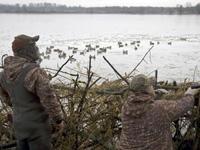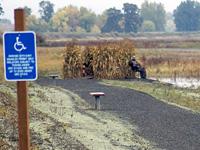
Hunting Sauvie Island’s East Side Unit
A beginner's guide to waterfowl hunting on Sauvie Island - Hunting in the Eastside Unit. Part 2 of a 5 part series.

Table of contents
Part 1: A Beginner's Guide to Waterfowl Hunting on Sauvie Island - An Introduction
Part 2: Hunting Sauvie Island’s East Side Unit (you are here)
Part 3: Hunting Sauvie Island’s West Side Unit
Part 4: Hunting Sauvie Island’s North Side Unit
Part 5: Goose Hunting on Sauvie Island
How to hunt the Eastside Unit
Eastside Unit Map (pdf)
Eastside Unit Blinds Map (pdf)
Oak Island Subunit Map (pdf)
Getting there
The Eastside is comprised of 14 individual hunting subunits. Access to all Eastside subunits is permitted only after obtaining a SIWA hunting permit at ODFW’s Eastside check station, which is located approximately 11 miles from the Sauvie Island Bridge, at the intersection of Reeder and Rentenaar roads. To get to the check station, from Hwy. 30, cross the Sauvie Island Bridge and stay straight on Sauvie Island Road. Follow Sauvie Island Road for 2 miles until it forks. At the fork, bear right and stay on Reeder Road for 9 miles. The check station is a small, light gray building on the left.
Getting a SIWA Eastside hunting permit
The Eastside or “food crop” area has the greatest number of individual hunting units and is the most popular among hunters. These lands are managed to provide abundant natural foods or are planted with corn, millet, buckwheat and alfalfa to provide food and habitat for the birds and to reduce their impact on surrounding private lands. On weekends especially, there is often more demand for hunting than the area can meet. That is why years ago ODFW adopted a reservation system for allocating hunting permits for Eastside subunits. Under this system, hunters have two possible ways of obtaining a permit. Those methods are as follows:
Option #1
The first method is to apply for a reservation through ODFW’s computerized controlled hunt system. Using this method, the hunter pays a small fee to participate in a random drawing that can be entered through the Electronic Licensing System either online, at ODFW offices or, license agents. The hunter can choose up to five Eastside subunits in each of seven drawings conducted about every two weeks from September through December. Those who are successful in a drawing will be assigned a random check-in sequence number along with their reservation. This number will correspond to the order in which they will pick a blind or check-in for a roam unit. For example, there are five available blinds in the Racetrack Unit and each successful applicant for the Racetrack Unit would receive a random number from 1 to 5. The hunter with #1 will have first choice of blinds, the hunter with #2 will have second choice of blinds, and so on and so forth.
Hunters will see this check-in sequence number when they check their controlled hunt results. Reservation hunters must be in line at least two hours before shooting time and will be called via AM Radio Station 1580 to the check station by the check-in sequence number. Hunters must park in the right lane of the reservation check-in road and use the left lane to proceed to the check station when called forward and your hunting license will be cross referenced with the reservation list at the check station. Beginning shooting times vary throughout the season, depending on when the sun comes up in the morning. Shooting times are listed chronologically in a table published in the Oregon Game Bird Regulations and here.
Option #2
Unfilled reservations are available to hunters without reservations on a first-come, first-served basis at the check station beginning 1 hour before shooting time. Separate vehicle lines are designated for reservation and non-reservation hunters.
Note: With both options, anybody who receives a SIWA hunting permit for a blind is permitted to invite up to three other persons to hunt in the blind with them. However, those who receive roam permits may only be accompanied by one other person, and that person may not hunt.
What’s available in the Eastside Unit
If you are lucky enough to get a SIWA hunting permit, one of the things you’ll want to know is something about the types of hunting positions that are available. Basically, your choices are to hunt from a fixed location in blinds built and maintained by ODFW staff and volunteers or to hunt in a “roam” unit where hunters are free to walk around or build their own makeshift blind with a camouflage net and/or natural materials.
The Eastside is comprised of 14 individual hunting subunits. The number of hunters allowed in each of these units varies through the season. Five of the 14 are “blind” subunits and the other nine are “roam” subunits, as follows:
Eastside Blind Subunits
| Hunt | 8 regular blinds, 1 ADA accessible blind |
| Johnson | 5 slotted tree/vegetation blinds & 2 lake side blinds |
| Mudhen | 12 regular blinds, 1 ADA accessible blind |
| Oak Island | 6 seasonal blinds, best for ducks when water is high |
| Racetrack | 5 regular blinds |
Eastside Roam Subunits
| Aaron | up to 10 hunters |
| Deadwillow | up to 10 hunters |
| Footbridge | up to 8 hunters |
| Malarky | up to 10 hunters |
| McNary | up to 20 hunters |
| Pope Lake | up to 8 hunters |
| Reeder | 1 party of up to four hunters |
| Rentenaar | up to 10 hunters |
| Stutzer | up to 8 hunters |
All Eastside subunits except Hunt, Johnson, Oak Island, Mudhen and Racetrack are “roam” areas in which hunters are free to set up at any location, so long as they do not interfere with hunters already in place. In the five “blind” units, hunters are required to shoot from fixed locations where there are bench style hunting blinds that have been camouflaged with corn stalks, branches and other materials. Two of these subunits have blinds reserved for individuals with disabled hunter permits.
Hunters who enjoy hunting from a boat should consider Aaron, McNary or Malarky subunits. Hunters are also allowed to check into the Crane subunit through the Eastside check station, although the subunit is located in the Westside Unit. This is only allowed if hunt locations remain after the random drawing on the Westside Unit has been completed.
Header photo by Kathy Munsel



